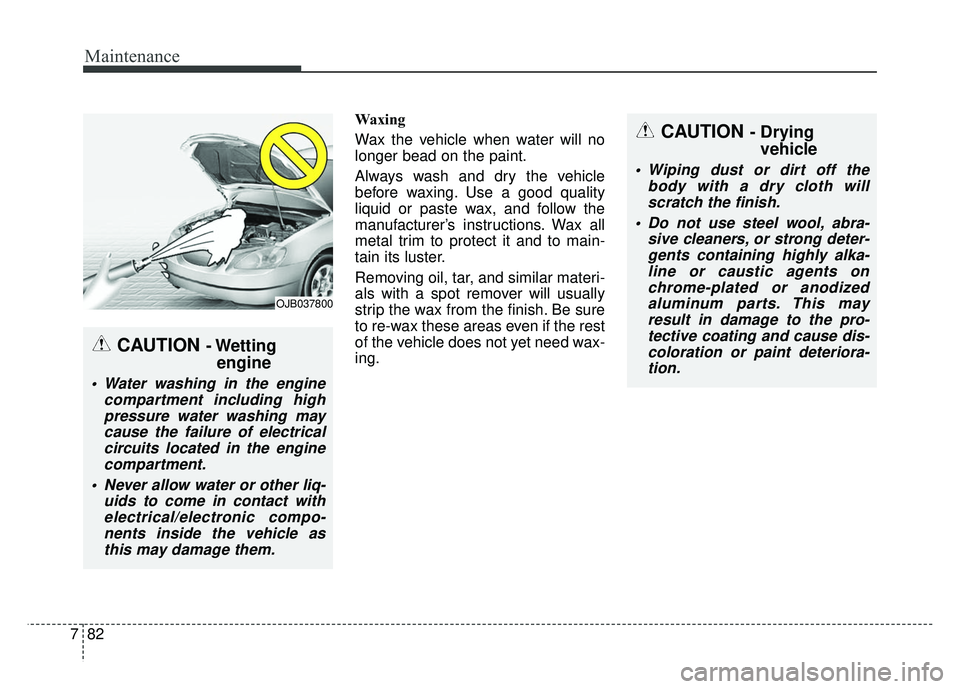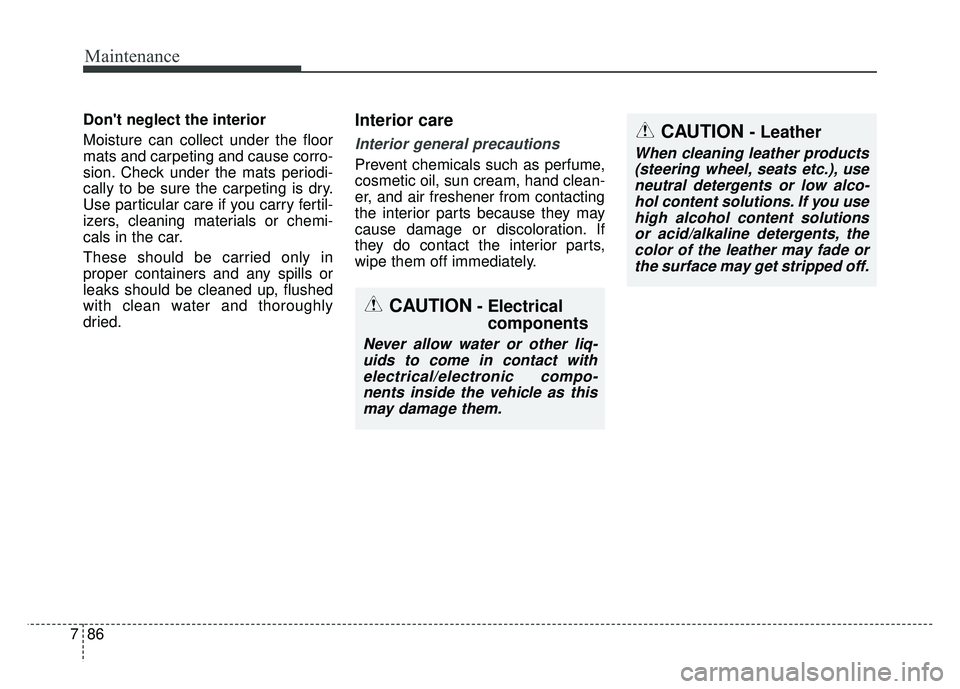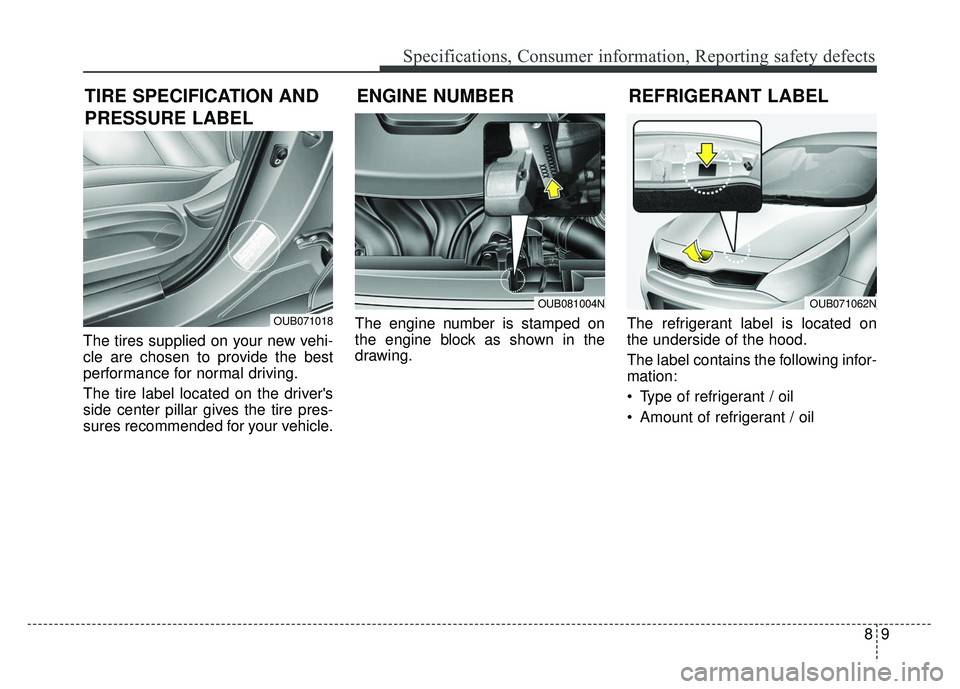2014 KIA RIO HATCHBACK oil
[x] Cancel search: oilPage 399 of 446

769
Maintenance
Always handle them carefully, and
avoid scratches and abrasions. If the
bulbs are lit, avoid contact with liq-
uids. Never touch the glass with bare
hands. Residual oil may cause the
bulb to overheat and burst when lit. A
bulb should be operated only when
installed in a headlight.
If a bulb becomes damaged or
cracked, replace it immediately and
carefully dispose of it.
Wear eye protection when changing
a bulb. Allow the bulb to cool down
before handling it.1.Turn off the engine and open the
hood.
2.Remove the front bumper upper cover.
3.Remove the headlight assembly from the body of the vehicle. If you
can reach the bulb without remov-
ing the headlight assembly, you do
not need to do step 2 and 3.
4.Disconnect the power connector(s) from the back of the headlight
assembly. Headlight(High/Low)
4 door
5.Remove the headlight bulb cover by turning it counterclockwise.
6.Unsnap the headlight bulb retain- ing wire by depressing the end and
pushing it right ward.
7.Pull the bulb out of the socket.
8.Insert a new bulb into the socket.
9.Install the socket in the assembly by aligning the shape on the bulb
housing in the assembly. Pushing
the spring holder in to the slot.
10. Install the headlight bulb cover by turning it clockwise
OUB071073
Page 412 of 446

Maintenance
82
7
Waxing
Wax the vehicle when water will no
longer bead on the paint.
Always wash and dry the vehicle
before waxing. Use a good quality
liquid or paste wax, and follow the
manufacturer’s instructions. Wax all
metal trim to protect it and to main-
tain its luster.
Removing oil, tar, and similar materi-
als with a spot remover will usually
strip the wax from the finish. Be sure
to re-wax these areas even if the rest
of the vehicle does not yet need wax-
ing.
CAUTION - Wetting
engine
Water washing in the engine
compartment including highpressure water washing maycause the failure of electricalcircuits located in the enginecompartment.
Never allow water or other liq- uids to come in contact withelectrical/electronic compo-nents inside the vehicle asthis may damage them.
OJB037800
CAUTION - Drying vehicle
Wiping dust or dirt off the
body with a dry cloth willscratch the finish.
Do not use steel wool, abra- sive cleaners, or strong deter-gents containing highly alka-line or caustic agents onchrome-plated or anodizedaluminum parts. This mayresult in damage to the pro-tective coating and cause dis-coloration or paint deteriora-tion.
Page 416 of 446

Maintenance
86
7
Don't neglect the interior
Moisture can collect under the floor
mats and carpeting and cause corro-
sion. Check under the mats periodi-
cally to be sure the carpeting is dry.
Use particular care if you carry fertil-
izers, cleaning materials or chemi-
cals in the car.
These should be carried only in
proper containers and any spills or
leaks should be cleaned up, flushed
with clean water and thoroughly
dried.Interior care
Interior general precautions
Prevent chemicals such as perfume,
cosmetic oil, sun cream, hand clean-
er, and air freshener from contacting
the interior parts because they may
cause damage or discoloration. If
they do contact the interior parts,
wipe them off immediately.
CAUTION- Electrical
components
Never allow water or other liq-
uids to come in contact withelectrical/electronic compo-nents inside the vehicle as thismay damage them.
CAUTION - Leather
When cleaning leather products(steering wheel, seats etc.), useneutral detergents or low alco-hol content solutions. If you usehigh alcohol content solutionsor acid/alkaline detergents, thecolor of the leather may fade orthe surface may get stripped off.
Page 417 of 446

787
Maintenance
Cleaning the upholstery and inte-rior trim
Vinyl
Remove dust and loose dirt from
vinyl with a whisk broom or vacuum
cleaner. Clean vinyl surfaces with a
vinyl cleaner.
Fabric
Remove dust and loose dirt from fab-
ric with a whisk broom or vacuum
cleaner. Clean with a mild soap solu-
tion recommended for upholstery or
carpets. Remove fresh spots imme-
diately with a fabric spot cleaner. If
fresh spots do not receive immediate
attention, the fabric can be stained
and its color can be affected. Also, its
fire-resistant properties can be
reduced if the material is not proper-
ly maintained.
Using anything but recommended
cleaners and procedures may affect
the fabric’s appearance and fire-
resistant properties.
Cleaning the lap/shoulder beltwebbing
Clean the belt webbing with any mild
soap solution recommended for
cleaning upholstery or carpet. Follow
the instructions provided with the
soap. Do not bleach or re-dye the
webbing because this may weaken
it.
Cleaning the interior windowglass
If the interior glass surfaces of the
vehicle become fogged (that is, cov-
ered with an oily, greasy or waxy
film), they should be cleaned with
glass cleaner. Follow the directions
on the glass cleaner container.
CAUTION - Rear windows
Do not scrape or scratch the
inside of the rear window. Thismay result in damage to the rearwindow defroster grid.
Page 427 of 446

Specifications, Consumer information, Reporting safety defects
68
RECOMMENDED LUBRICANTS AND CAPACITIES
To help achieve proper engine and powertrain performance and durability, use only lubricants of the proper quality.
The correct lubricants also help promote engine efficiency that results in improved fuel economy.
These lubricants and fluids are recommended for use in your vehicle.
*1Refer to the recommended SAE viscosity numbers on the next page.
*2Engine oils labeled Energy Conserving Oil are now available. Along with other additional benefits, they contribute
to fuel economy by reducing the amount of fuel necessary to overcome engine friction. Often, these improvements
are difficult to measure in everyday driving, but in a year’s time, they can offer significant cost and energy savings.
*
3If the API service SM engine oil is not available in your country, you are able to use API service SL.
Lubricant Volume Classification
Engine oil *1 *2 (drain and refill)
recommended (or equivalent) 3.8 US qt. (3.6 l)
Manual transaxle fluid 1.9 ~ 2.01 US qt.
API GL-4, SAE 75W/85
(1.8 ~ 1.9 l) approved by Kia Motors Corp.
MICHANG ATF SP-IV, SK ATF SP-IV
Automatic transaxle 1.6 Engine 7.71 US qt. (7.3 l) NOCA ATF SP-IV, Kia genuine ATF SP-IV or
fluid other brands meeting the above specification
approved by Kia Motor Co.,
Coolant Automatic transaxle 5.6 US qt. (5.5 l) Mixture of antifreeze and distilled water
Manual transaxle 5.8 US qt. (5.3 l) (Ethylene glycol base coolant for aluminum radiator)
Brake/Clutch fluid 0.7~0.8 US qt.
FMVSS116 DOT-3 or DOT-4
(0.7~0.8 l)
Fuel 11.3 US gal. (43 l) Refer to “Fuel requirements” in s
ection 1
API Service SM*3,
ILSAC GF-4 or above
Page 428 of 446

87
Specifications, Consumer information, Reporting safety defects
Recommended SAE viscosity
number
Always be sure to clean the area
around any filler plug, drain plug, or
dipstick before checking or draining
any lubricant. This is especially
important in dusty or sandy areas
and when the vehicle is used on
unpaved roads. Cleaning the plug
and dipstick areas will prevent dirt
and grit from entering the engine and
other mechanisms that could be
damaged.Engine oil viscosity (thickness) has
an effect on fuel economy and cold
weather operation (engine start and
engine oil flowability). Lower viscosi-
ty engine oils can provide better fuel
economy and cold weather perform-
ance, however, higher viscosity
engine oils are required for satisfac-
tory lubrication in hot weather. Using
oils of any viscosity other than those
recommended could result in engine
damage.
When choosing an oil, consider the
range of temperature your vehicle
will be operated in before the next oil
change. Proceed to select the rec-
ommended oil viscosity from the
chart.
Temperature Range for SAE Viscosity Numbers
Temperature
Gasoline
Engine Oil *1
°C
(°F)-30 -20 -10 0 10 20 30 40 50
-10 0 20 40 60 80 100 120
*1For better fuel economy, it is recommended to use the
engine oil of a viscosity grade SAE 5W-20 (API SM /
ILSAC GF-4). However, if the engine oil is not avail-
able in your country, select the proper engine oil using
the engine oil viscosity chart.
10W-30
5W-20, 5W-30
Page 430 of 446

89
Specifications, Consumer information, Reporting safety defects
The tires supplied on your new vehi-
cle are chosen to provide the best
performance for normal driving.
The tire label located on the driver's
side center pillar gives the tire pres-
sures recommended for your vehicle.The engine number is stamped on
the engine block as shown in the
drawing.
The refrigerant label is located on
the underside of the hood.
The label contains the following infor-
mation:
Type of refrigerant / oil
Amount of refrigerant / oil
OUB081004N
ENGINE NUMBER
REFRIGERANT LABELTIRE SPECIFICATION AND
PRESSURE LABEL
OUB071018
OUB071062N
Page 439 of 446

Index
4I
Economical operation ··················\
··················\
················5-46
Electric power steering ··················\
··················\
··············4-39
Electronic stability program (ESC) ··················\
·············5-27
Emergency starting ··················\
··················\
··················\
····6-5Jump starting ··················\
··················\
··················\
···········6-5
Push starting ··················\
··················\
··················\
············6-7
Emergency while driving ··················\
··················\
·············6-3
Emission control system ··················\
··················\
············7-88 Crankcase emission control system··················\
···········7-88
Evaporative emission control System ··················\
·······7-88
Exhaust emission control system ··················\
··············7-89
Engine ··················\
··················\
··················\
··················\
······8-2
Engine compartment ··················\
··················\
··················\
··2-6
Engine compartment panel fuse ··················\
··················\
7-58
Engine coolant ··················\
··················\
··················\
·········7-27
Engine coolcant temperature gauge··················\
·············4-47
Engine number ··················\
··················\
··················\
···········8-9
Engine oil ··················\
··················\
··················\
·················7-26\
Engine overheats ··················\
··················\
··················\
········6-8
Engine start/stop button ··················\
··················\
···············5-7
Engine will not start··················\
··················\
··················\
···6-4
Evaporative emission control System ··················\
··········7-88
Exhaust emission control system··················\
·················7-89\
Explanation of scheduled maintenance items ···············7-23
Exterior care··················\
··················\
··················\
·············7-81 Flat tire (with spare tire) ··················\
··················\
············6-14
Jack and tools ··················\
··················\
··················\
········6-14
Changing tires··················\
··················\
··················\
········6-15
Compact spare tire ··················\
··················\
··················\
·6-20
Removing and storing the spare tire···········\
·················6-15\
Flat tire (with tire mobility kit) ··················\
··················\
·6-22
Floor mat anchor(s) ··················\
··················\
·················4-10\
7
Fluid Automatic transaxle fluid ··················\
··················\
········7-31
Brakes/clutch fluid··················\
··················\
··················\
·7-30
Washer fluid··················\
··················\
··················\
···········7-31
Folding the outside rearviwe mirror ··················\
············4-44
Folding the rear seat ··················\
··················\
··················\
3-10
Front passenger and rear seat belt ··················\
···············3-17
Front seat adjustment ··················\
··················\
··················\
·3-4
Fuel filler lid ··················\
··················\
··················\
············4-32
Fuel gauge··················\
··················\
··················\
················4-47
Fuel requirements ··················\
··················\
··················\
······1-3
Fuses ··················\
··················\
··················\
··················\
······7-56 Engine compartment panel fuse ··················\
················7-58
Fuse/relay panel description ··················\
··················\
····7-59
Instrument panel fuse ··················\
··················\
··············7-57
Memory fuse··················\
··················\
··················\
··········7-58
Multi fuse ··················\
··················\
··················\
··············7-59
FE